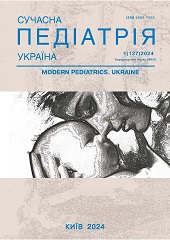Diagnosis and treatment of toxocariasis in children in modern conditions
DOI:
https://doi.org/10.15574/SP.2024.137.124Keywords:
children, toxocariasis, visceral toxocarosis, eye toxocarosis, immunoenzymatic analysisAbstract
Toxocariasis is a parasitic disease that is most often caused by roundworms in cats and dogs. Helminthiasis is endemic throughout Ukraine and causes significant morbidity in children, including damage to the lungs, liver, central nervous system, and eyes.
Purpose - to take into account the large number of displaced persons from the south and east of Ukraine, the growth of the population of homeless animals, the lack of deworming of them and pets, to analyze the data of the clinical examination of children who were treated in the departments of the “DCL No. 4 Kyiv” diagnosis and treatment of toxocariasis in children.
Three clinical cases of toxocariasis in children are presented. 1. A 3-year-old boy was admitted to the clinic with a diagnosis of acute bronchitis. An increase in the titer of toxocarosis antibodies (Ig G 1: 200) was detected, which indicated an invasion that had once occurred, and not an acute disease. The child was subject to dispensary observation by an infectious disease specialist and a general practitioner with an examination every 2 months. When clinical signs of toxocarosis appear, specific therapy is recommended. 2. Boy, 3.5 years old. was in the neurological department due to a neurosis-like condition in the form of sleep disturbance (restless sleep), febrile convulsions in the anamnesis. This case demonstrates the propensity of visceral toxocarosis to a long-term relapsing course, which was confirmed by the detection of IgG - toxocar avid antibodies with an avidity index of 60, which indicates a chronic invasion and requires specific treatment. 3. A 10-year-old girl was being treated in the eye department. The child was diagnosed with ocular form of toxocariasis, treated: anti-inflammatory, anti-parasitic, surgical.
Conclusions. Toxocariasis in children is an urgent problem in pediatrics, and the solution of its aspects depends on the introduction of the latest methods of diagnosis, treatment and prevention into the clinical practice of health care, as well as on the coordinated cooperation of pediatric and veterinary services.
The research was carried out in accordance with the principles of the Declaration of Helsinki.
Informed consent of the child’s parents was obtained for the research.
No conflict of interests was declared by the authors.
References
Del Brutto OH. (2017). Parasitic infections of the central nervous system. CNS Infections.: 181-197. https://doi.org/10.1007/978-3-319-70296-4_9
Despommier D. (2003). Toxocariasis: Clinical aspects, epidemiology, medical ecology, and molecular aspects. Clin Microbiol Rev. 16 (2): 265-272. https://doi.org/10.1128/CMR.16.2.265-272.2003; PMid:12692098 PMCid:PMC153144
Good B, Holland CV, Taylor MR et al. (2004). Ocular toxocariasis in schoolchildren. Clin Infect Dis. 39 (2): 173-178. https://doi.org/10.1086/421492; PMid:15307025
Hafliðadóttir HS, Juhl CB, Nielsen SM, Henriksen M, Harris IA, Bliddal H, Christensen R. (2021). Placebo response and effect in randomized clinical trials: Meta-research with focus on contextual effects. Trials. 22: 493. https://doi.org/10.1186/s13063-021-05454-8; PMid:34311793 PMCid:PMC8314506
Hamilton CM, Yoshida A, Pinelli E, Holland CV. (2014). Toxocariasis. In Helminth Infections and their Impact on Global Public Health; Bruschi, F., Ed.; Springer: Vienna, Austria: 425-455. https://doi.org/10.1007/978-3-7091-1782-8_14
Ma G, Holland CV, Wang T, Hofmann A, Fan CK, Maizels RM, Hotez PJ, Gasser RB. (2018). Human toxocariasis. Lancet Infect. Dis. 1: 14-24. https://doi.org/10.1016/S1473-3099(17)30331-6; PMid:28781085
Macpherson CN. (2013). The epidemiology and public health importance of toxocariasis: A zoonosis of global importance. Int J Parasitol. 43 (12-13): 999-1008. https://doi.org/10.1016/j.ijpara.2013.07.004; PMid:23954435
Magnaval JF, Bouhsira E, Fillaux J. (2022). Therapy and prevention for human toxocariasis. Microorganisms. 10: 241. https://doi.org/10.3390/microorganisms10020241; PMid:35208697 PMCid:PMC8875715
Magnaval JF, Fillaux J, Berry A. (2022). A Retrospective Study of the Efficacy of Albendazole and Diethylcarbamazine for the Treatment of Human Toxocariasis. Pathogens. 11 (7): 813. https://doi.org/10.3390/pathogens11070813; PMid:35890057 PMCid:PMC9317386
Magnaval JF, Laurent G, Gaudré N, Fillaux J, Berry A. (2017). A diagnostic protocol designed for determining allergic causes in patients with blood eosinophilia. Mil. Med. Res. 4: 15. https://doi.org/10.1186/s40779-017-0124-7; PMid:28546866 PMCid:PMC5440933
Noordin R, Smith HV, Mohamad S et al. (2005). Comparison of IGG-ELISA and IGG4-ELISA for Toxocara serodiagnosis. Acta Trop. 93 (1): 57-62. https://doi.org/10.1016/j.actatropica.2004.09.009; PMid:15589798
Overgaauw PA. (1997). Aspects of Toxocara epidemiology: toxocarosis in dogs and cats. Crit Rev Microbiol. 23 (3): 233-251. https://doi.org/10.3109/10408419709115138; PMid:9347222
Rostami A, Ma G, Wang T, Koehler AV, Hofmann A, Chang BCH, Macpherson CN, Gasser RB. (2019). Human toxocariasis-A look at a neglected disease through an epidemiological 'prism'. Infect. Genet. Evol. 74: 104002. https://doi.org/10.1016/j.meegid.2019.104002; PMid:31412276
Downloads
Published
Issue
Section
License
Copyright (c) 2024 Modern pediatrics. Ukraine

This work is licensed under a Creative Commons Attribution-NonCommercial 4.0 International License.
The policy of the Journal “MODERN PEDIATRICS. UKRAINE” is compatible with the vast majority of funders' of open access and self-archiving policies. The journal provides immediate open access route being convinced that everyone – not only scientists - can benefit from research results, and publishes articles exclusively under open access distribution, with a Creative Commons Attribution-Noncommercial 4.0 international license (СС BY-NC).
Authors transfer the copyright to the Journal “MODERN PEDIATRICS. UKRAINE” when the manuscript is accepted for publication. Authors declare that this manuscript has not been published nor is under simultaneous consideration for publication elsewhere. After publication, the articles become freely available on-line to the public.
Readers have the right to use, distribute, and reproduce articles in any medium, provided the articles and the journal are properly cited.
The use of published materials for commercial purposes is strongly prohibited.

